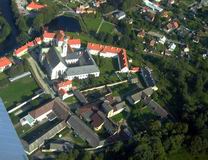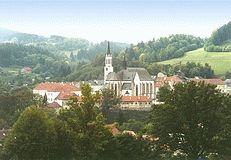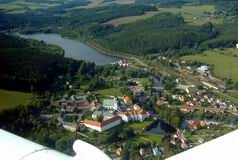
The monastery in the small town Vyšší Brod stands on the western outskirts of the town above the Vltava river. It is one of the most significant sights of the Gothic sacred architecture in the Czech Republic.
The monastery was founded before 1259 by Vok of Rožmberk near the small guard village near the so-called Upper Ford, which lay across the Vltava river in this place. It was intended to be a family burial place. The construction of the monastery, which belonged to the Cistercians, finished at the end of the 14th century. At the beginning of the 15th century the monastery was fortified and during the 17th and 18th centuries it was enlarged in the Baroque style. A lot of new buildings and the so-called Second Abbey with the originally Gothic St. Anne's Chapel were built at that time. The present appearance comes from the Neo-Gothic reconstruction between 1830 - 1883. During the second half of the 20th century (at the time of communist regime) the monastery was damaged. Since 1991 it has been back under the ownership of the Cistercians and it has been reconstructed and it is open to the public.
The closed and fortified precinct contains farm buildings, a monastery, an abbey and the Church of the Assumption of Virgin Mary. The oldest and most important part comprises the Church of the Assumption of Virgin Mary, a chapter hall and a cloister.
The convent, adjoining with the south aisle of the Church of the Assumption of Virgin Mary, was built between 1280 - 1385. The so-called Paradise Courtyard is enclosed with a cloister from the second half of the 14th century. In its east wing there is a chapter hall from about 1280. The hall is arched by the system, which is unique in the whole of Europe - four fields of tripartite ribbed vault fit to a centric clustered abutment.
There is a preserved big library from the 17th century with valuables prints, incunables and manuscripts (the oldest ones originate from the 12th century) in the monastery. The gallery of European paintings of the 17th and 18th centuries, mostly Dutch, is situated here too.
The former Second Abbey was adapted for the Post Museum (history of postal and telecommunications services, stamps, mail cars etc.).
 |
 |